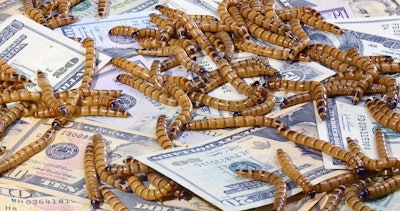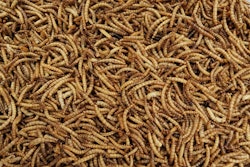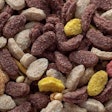
Over the past several years, insects have generated a lot of hype and hope as a novel source of protein for pet food (and food for other species, including humans). Studies have shown the nutritional value of insect protein for companion animals and its potential as a more sustainable source; surveys have also indicated that a certain portion of pet owners are at least open to the idea of feeding pet foods with insect protein.
As more suppliers of this type of protein arise worldwide and work to scale up to create efficiencies and a more affordable pricing structure, research is also starting to reveal some caveats and even controversy. For example, a U.K. government study released in May 2025 cast doubt on the sustainability of insect meal (especially that derived from black solder fly larvae, or BSFL), then was quickly critiqued by a trade association.
Another study released in May, conducted by researchers at Seoul National University, found discrepancies between labeled and actual content of certain nutrients in pet foods with insect protein available in Korea, possibly highlighting a need for enhanced regulatory oversight in that market.
This is all likely an inevitable phase in the development of a new category of anything, not just pet food protein, but it does seem to call for taking a breath and evaluating where the insect protein sector may be heading — including finding answers to the persistent, nagging question of whether a significant number of pet owners will ever accept insect protein in pet food.
What do today’s pet owners think of insect protein?
To that end, recent consumer research shows the protein source’s current status. Lonnie Hobbs, Ph.D., assistant professor in the Department of Agricultural Economics at Kansas State University (KSU), and his colleague Aleksan Shanoyan, Ph.D., professor, have been surveying U.S. pet owners about their knowledge and perceptions of various novel proteins for more than a year now. One of their recent surveys asked 763 U.S. dog owners about insect protein, finding knowledge gaps and some confusion.
For instance, only 33% of respondents believed a positive attribute for insects was providing a source of high protein; that was the positive most identified for the category. “I don’t know” came in second at 28%. “Healthy” and “natural” were named as positives by 26% and 20% respectively, while 18% of respondents believed insect protein has no positives. Only 15% named sustainability as a positive.
Perhaps counteracting all that, 30% of respondents said they didn’t know of any negatives of insect protein, though 23% believed dogs dislike it, followed by 20% seeing it as a cheap meat replacement and 19% as less nutritious than meat.
Bottom line: Purveyors of pet foods with insect protein and its suppliers have their work cut out for them in educating pet owners.
However, the picture isn’t completely daunting: Hobbs and Shanoyan found that 9% of the survey respondents already purchase dog food with insect protein; 25% said they’re willing to purchase it, and 46% said they “may be open to purchasing it” in the future. (That seems pretty nebulous!) On the other hand, 18% said they’d never purchase dog food with insect protein.
The research did show that some respondents open to feeding insect protein were willing to pay more for dog food with it, at least more compared to dog food with plant-based protein. Willingness to pay more depended on income level, unsurprisingly.
Another survey, this one conducted by Nextin Research by Marketplace and involving about 1,200 each of U.S. dog owners and cat owners, yielded similar results in terms of willingness to feed and purchase pet food with insect protein. Specifically, 9% of the dog owners and 12% of the cat owners said they would consider giving their pets a sample pet food made with cricket protein; for BSFL, it was only 4% and 6%, respectively.
In addition, 41% of dog owners and 38% of cat owners said they would be less likely to purchase a pet food made with insect protein; 15% or less of all the owners said they would be more likely to buy such a pet food but wouldn’t pay more for it, while about the same percentage said they would be more likely to buy it and to pay more.
‘Partial replacement strategy’ for insect protein
Perhaps another recent study highlights a way to overcome some of these issues. Conducted by researchers in the Department of Grain & Science at KSU and published in early July, it examined BSFL meal and cricket flour as alternative pet food proteins to traditional poultry and fish meals. The study found the insect proteins presented unique processing hurdles during extrusion that affect kibble quality and consistency. These manufacturing challenges arose when the insect proteins were incorporated at 30% inclusion levels.
“However, the research revealed a more promising approach: Using BSFL meal at reduced inclusion rates (10%) alongside poultry meal significantly improved both processing stability and final product quality while maintaining the sustainability benefits,” wrote my colleague, Lisa Cleaver. In other words, instead of completely replacing a traditional protein source in a pet food with insect protein, a partial replacement strategy might be more viable.
The researchers also recommended considering reducing fat content in high-fat insect meals like cricket flour to improve processing performance, and optimizing a formulation by adjusting complementary ingredients and extrusion parameters to accommodate the unique characteristics of insect proteins.
No doubt many pet food companies utilizing insect protein in their products have already figured at least some of this out. Yet the “partial replacement strategy” concept got me wondering: Would that also make sense in terms of pet owner acceptance of insect protein?
An intermittent step to acceptance?
Put another way: Would inclusion of insect protein at lower levels, and in conjunction with other, more traditional protein sources, also help pet owners feel more comfortable feeding foods with insect protein, help them ease into trying such foods? An analogy could be the use of fresh or freeze-dried toppers to let pet owners (and their pets) try out those different formats. (Of course, pet owners can also try insect protein by feeding pet treats including it.)
This could be an intermittent step; it wouldn’t go as far in solving issues such as needing to find other sources of protein, especially more sustainable ones, but it could help get closer to cracking the code for insects to become a mainstream source of protein in pet foods.


















